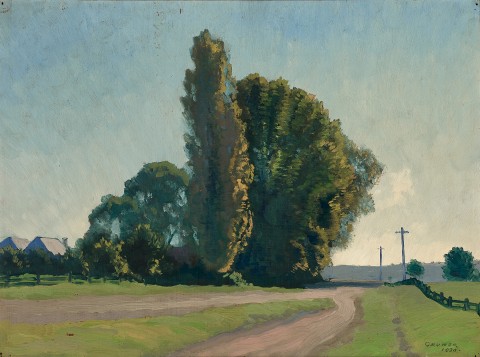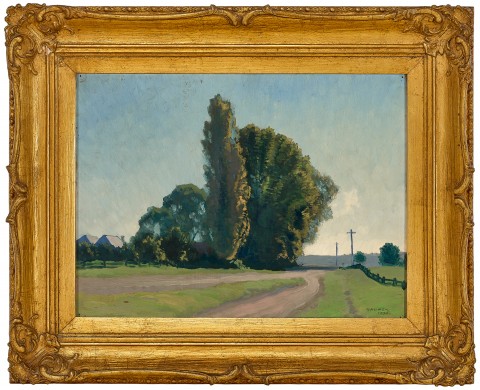Landscape, Bacchus Marsh, 1930
Elioth Gruner
oil on cedar panel
30.0 x 40.0 cm
signed and dated lower right: GRUNER / 1930
bears inscription verso: LANDSCAPE / BACCHUS MARSH (W. BUCKLE)
The artist, Sydney (probably ledger no. 370, as ‘Road with poplar’)
W. G. Buckle, by 1933
Arthur Hancock, Melbourne
Thence by descent
Private collection, Melbourne
Thence by descent
Private collection, Melbourne
Exhibition of Pictures from Southern States, Queensland National Art Gallery, Brisbane, 22 July – 16 August 1930, cat. 8a (as ‘A road near Bacchus Marsh’)
Loan Exhibition of the Works of Elioth Gruner, National Art Gallery of New South Wales, Sydney, 21 December 1932 – 21 February 1933, cat. 43
Elioth Gruner Memorial Loan Exhibition, National Art Gallery of New South Wales, Sydney, 17 April – 31 May 1940, cat. 39, lent by Mr W.G. Buckle (label attached verso)
Art in Australia, Sydney Ure Smith, Sydney, 3rd Series, no. 50, June 1933, p. 37 (illus., as 'Landscape, Bacchus Marsh, Victoria')
Morning, Bacchus Marsh, Victoria, 1930, oil on canvas, 50.5 x 61.0 cm, private collection, sold Deutscher and Hackett, Sydney, 22 November 2023, lot 27
Werribee Gorge, 1930, oil on canvas on cardboard, 30.0 x 40.7 cm, National Gallery of Victoria, Melbourne
We are grateful to Steven Miller for his assistance with this catalogue entry.
Landscape, Bacchus Marsh, 1930, dates from a pivotal period in the career of Elioth Gruner when the many personal painting challenges he had undertaken over the previous seven years coalesced into his instantly recognisable mature technique. It was executed in the same year as two other significant works: Morning, Bacchus Marsh, Victoria, 1930 (Deutscher and Hackett, Sydney, 22 November 2023, lot 27), and the widely reproduced Mitchell River, Victoria (aka Gippsland lakes), 1930 (Deutscher and Hackett, Sydney, 14 September 2022, lot 24). These painting challenges had been triggered by an encounter with the British artist Sir William Orpen in 1923, who criticised Gruner’s technique and design, encouraging him to change to smaller canvases and to utilise a thinner, more pastel-like application of paint. Gruner subsequently travelled to Europe looking closely at post-impressionists such as Paul Gauguin and absorbing their lessons on the flattening of space. Although some colleagues in Australia – most famously Norman Lindsay – were appalled by his subsequent, mildly modernist approach, audiences responded strongly to the new works, and between 1929 and 1937, Gruner added four more Wynne Prize awards for landscape painting to the three he already possessed.1 These included the now-iconic On the Murrumbidgee, 1929 (Art Gallery of New South Wales) shown in the competition in early 1930, a ‘high point of his progression towards creating modern landscape from a plein air practice of direct observation before the subject.’2
Buoyed by his success, Gruner undertook an extended drive through the south coast of New South Wales and on to the Gippsland region of Victoria where he painted Mitchell River, Victoria (aka Gippsland lakes), 1930. Following this, he travelled back to Melbourne and by May, was in regional Bacchus Marsh on Woiwurrung and Wathaurong country. Notably, he was in the company of two significant artist-educators – namely, George Bell, who would open his renowned modernist school two years later, and Daryl Lindsay, member of the famed artistic family and future Director of the National Gallery of Victoria.3 This was a working holiday charged with much intellectual discussion and analysis, and contemporaneous paintings by each bear witness to shifts in emphasis and technique. It is interesting to compare Lindsay’s and Gruner’s paintings in particular. Although both exhibit a marked flattening of space, in works such as Lindsay’s Landscape at Myrniong, c.1930, and Landscape at Bacchus Marsh, c.1930 (both in the collection of the National Gallery of Victoria), the brushwork comprises stipples of impasto strokes whilst the skies are filled with highly mannered clouds. By comparison, Gruner’s paintings from Bacchus Marsh demonstrate the continuing strength of his vision. In the lot on offer here, the majestic poplar and companion oak provide a central focus, whilst the forked roads lead the eye back to the foreground, bracketed by the boundary fence to the right and two small cottages at the left. However, it is the sensual pleasure that Gruner expresses with his sky and clouds that truly completes the image. Taking cues from other modernist contemporaries such as Grace Cossington Smith (see Gum Blossom, c.1928 – 32, Deutscher and Hackett, Melbourne, 28 August 2024, lot 49), the blue brushstrokes radiate to the heavens, while the clouds on the horizon impart a true sense of reality. Indeed, Gruner himself was also impressed, writing to the critic Basil Burdett that he had ‘painted a sky at last.’4
1. Gruner was awarded the Wynne Prize in 1916, 1919, 1921, 1929, 1934, 1936, and 1937.
2. Clark, D., Elioth Gruner: Texture of light, Canberra Museum and Gallery, Australian Capital Territory, 2014, p. 12
3. Lindsay and his wife were temporarily renting a cottage at Bacchus Marsh, see: Lindsay, D., The leafy tree: my family, F.W. Cheshire, Melbourne, 1965, p. 153
4. Elioth Gruner, Letter to Basil Burdett, 29 May 1930 in Art Gallery of New South Wales archives, MS1995.9, 1/17/10.
ANDREW GAYNOR


